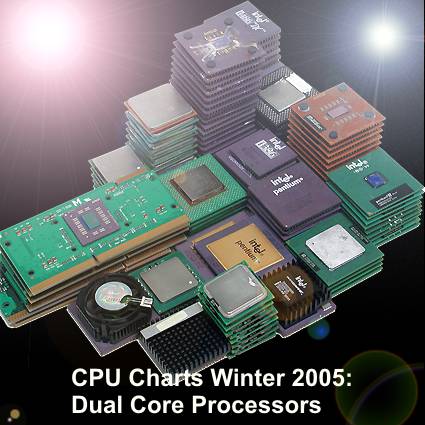The Mother of All CPU Charts 2005/2006
Charts Updated With Dual Cores
It's time for a new CPU comparison using our newly developed benchmark suite. The most noteworthy additions are certainly the dual-core processors, but we have also added some new sections focusing especially on the platforms for AMD's Socket 939 and Intel's Socket 775.
An overview as comprehensive as this one also brings up the question of what has changed over that period of time, and how much performance has improved. Naysayer are often quick to point out that your typical word processor doesn't run any faster today than it did in 1993, without qualifying this claim further. Are they completely off the mark?
Well, no, but let's not forget that the way we use our computers has also changed dramatically over the past decade. Today, CPUs handle many tasks simultaneously by running several applications in parallel. In the early 1990s, specialized chips would have been necessary to perform this feat which we take for granted today. Fluid video or audio streaming and playback were unthinkable back then, but are common now. A good current example of such an application is Internet telephony or video conferencing. Here, data is encrypted in real-time, while normal office applications or even games continue to run in parallel. Simply put, much of what we take for granted with computers today was not even on the radar screen just a few years ago.
Behold the first step in an incredibly fast evolutionary process: Intel's first processor, the 4004, circa 1971. It consisted of 2,300 transistors, required a core voltage of 12 V and could address up to 640 Bytes of memory. It didn't even require any heatsink.
This is a graph of the clock speed development of AMD and Intel processors from 1993 until the end of 2005. Between 1993 and 1999, the average clock speed increased tenfold. Then stagnation set in; over the past four years, frequencies haven't even doubled.
We must realize that the personal computer is edging its way into practically every aspect of our lives. The biggest part of this development was driven by two large processor companies, namely AMD and Intel, the latter of which has had decisive influence on the development of most of today's standards.
How about a few concise examples to illustrate the rapid developments of the past few years? Intel's first processor, the 4004, debuted in 1971 and consisted of 2,300 transistors. Compare that to the 230 million transistors found in today's Pentium Extreme Edition 840. That's an increase by a factor of 100,000!
Get Tom's Hardware's best news and in-depth reviews, straight to your inbox.
Let's try that again using a different measure. The space that used to be occupied by a single transistor now houses 5,845 of them. This development went hand in hand with a reduction in core voltage from 12 V (1971) to currently 1.2 V. And that's not even the lower limit; a conventional silicon-based transistor requires a minimum voltage of 0.7 V to perform one transition.
Current page: Charts Updated With Dual Cores
Next Page Thermal Dissipation Prevents Higher Clock SpeedsTom's Hardware is the leading destination for hardcore computer enthusiasts. We cover everything from processors to 3D printers, single-board computers, SSDs and high-end gaming rigs, empowering readers to make the most of the tech they love, keep up on the latest developments and buy the right gear. Our staff has more than 100 years of combined experience covering news, solving tech problems and reviewing components and systems.



